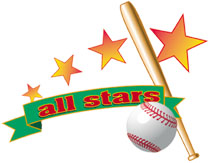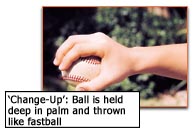News and Announcements
Junior Baseball Magazine On-Line We’ve talked about how to throw different kinds of fastballs and both the traditional and ‘safe’ curveball grips, too. The bottom line principle for young pitchers is to stick with the fastball until you’ve mastered it to the point where you can throw it for a strike, no matter the situation. But when the time comes to develop that second pitch, I suggest that it not be a curveball, but a ‘change of pace’, instead. For many pitchers your age, the curveball can be a pretty hard thing to throw for strikes. Even harder is developing the leverage needed to actually make the ball curve. The result often is a pitch that stays up in the strike zone. And curveballs that stay up are just another way of describing an extra-base hit waiting to happen. But a change-up is an easier pitch to master since the pitching motion for a change-up is (and really needs to be) exactly the same as you use when throwing the fastball. In fact, throwing it with the same motion is one of the principals behind the pitch. Change-ups are all about deception - making the batter think that a fastball is on the way. The difference is in the grip. Every-thing else remains the same. The change-up can be thrown with a variety of grips, the ‘circle change’ being the grip of choice. All you have to do is make an ‘OK’ sign with your thumb and first finger and place the ball snugly in the palm of your hand. Make sure the ball is held farther back in the hand than with your fastball grip. The pressure on the ball is applied with the middle knuckles. Again, this is different from the fastball, where the pressure is light and done by the fingertips. Someone should be able to take the ball from your hand without much effort when you’re using the fastball grip. Not so with the change-up. Some kids like using a ‘palm ball’ grip, which simply means you encase the ball, as much as you can, with all the fingers. Just find the grip that works best for you. Another important aspect of a good change-up, meaning one that stays down in the strike zone, is the follow-through. If your first attempts at throwing the change-up result in the ball bouncing somewhere near the top of the screen, just make sure your follow-through is more complete the next time. For a change-up to be successful, it doesn’t necessarily have to result in a swing and a miss for strike three. In fact, a lot of good coaches will say that you don’t want to throw a change-up for a strike with less than two strikes in the count. More often, a good change-up gets you one of those hoppers to shortstop for an easy out. Remember, getting the batter to think the fastball is coming is what a change-up is all about! If you can master the fastball, you’ll be able to get kids out in Little League. Master a second pitch and you’ll get them out in high school. Master a third pitch (curve, slider, etc.), and maybe some day you’ll be able to throw the ball for a living. Developing a good, consistent change-up is a terrific way to extend your baseball future. Just be patient, stick to the basics, and good things will happen. See The Picture Below For The Change-Up Grip !



All Standings are now kept on the game schedule site:
http://www.allprosoftware.net/RGMVM/aplsmasterschedule.htm



Click Above And Visit This Great Hitting Guru's Site. Visit Mike's Hitting Forum And Pick Up Some Great Hitting Tips ! Mike Epstein Carreer Highlights: Member, first United States Olympic baseball team [Japan, 1964] Still holds highest lifetime batting average at the University of California, Berkeley [.384] Class A California League Rookie-of-the-Year and Player-of-the-Year, League MVP [1965] Class AAA International League Rookie-of-the-Year and Player-of-the-Year, League MVP [1966] Sporting News and Topps Minor League Player-of-the-Year [1966] American League record, most putouts, first baseman one game, 32 [versus Chicago White Sox, 1967] Hit three home runs in one game [versus Chicago White Sox, 1969] Won prestigious Major League “Player Win Average” award in the American League, given to baseball’s most productive hitter. (Willie McCovey won it in the National League) [1969] One game, career-high eight runs-batted-in [versus Baltimore Orioles, 1970] Tied Major League record four consecutive home runs [versus Washington Senators, 1971] Member, World Champion Oakland Athletics. Led team in home runs [1972] Came in third in the American League home run race, 1972 Washington Senators club record, most home runs by a left-handed hitter, season, 30 [1969] Coach, San Diego Crush, 3-time Amateur World Champions [1991, 1992, 1994] Minor League Manager and Roving Hitting Instructor, Milwaukee Brewers, [1993] Minor League Hitting Coordinator San Diego Padres [2000


All of these drills improve speed and control/direction. 1. Stand facing toward the wall in your stride position (standing sideways). Take a ball and flick your ball straight to the wall and it should come right back to you. Only use you wrist no windmill. This drill can be done indoors with a rubber or incrediball, or outside with a regular ball against a pitchback. 2. This drill is also to be done in or outdoors. Stand 8ft. Away from the wall in your stride position, do your windmill and close your hips and the ball should come right back to you 3. This one is also to be done in or outdoors. Stand 6ft away from a wall in your stride position and just do your windmill do not close your hips, the ball should come right back to you, time yourself for 15 seconds and see how many you can do. Every time you do it see if you can get more than the time before. 4. The last drill should be done outside with a catcher. Get a weight ball and kneel down on one knee with your other knee facing the catcher. And only using your wrist snap flick the ball to your target or catcher. As you do 15 move back a couple of feet. When you're about 10ft from the plate use a regular ball. Then when you're about 20ft away from the plate do the windmill, until you can do this all the way from the rubber.
